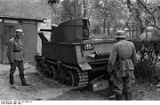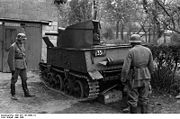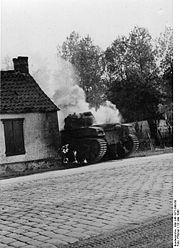
Belgian armoured fighting vehicles of World War II
Encyclopedia



Combat vehicle
A combat vehicle, also known as a ground combat vehicle, is a self-propelled, weaponized military vehicle used for combat operations. Combat vehicles can be wheeled or tracked.- Automation :...
s at the time of the German invasion in May 1940. They were assigned in "penny packets" to various infantry
Infantry
Infantrymen are soldiers who are specifically trained for the role of fighting on foot to engage the enemy face to face and have historically borne the brunt of the casualties of combat in wars. As the oldest branch of combat arms, they are the backbone of armies...
and cavalry
Cavalry
Cavalry or horsemen were soldiers or warriors who fought mounted on horseback. Cavalry were historically the third oldest and the most mobile of the combat arms...
divisions for use as support weapons. The Belgian army
Belgian Army
The Land Component is organised using the concept of capacities, whereby units are gathered together according to their function and material. Within this framework, there are five capacities: the command capacity, the combat capacity, the support capacity, the services capacity and the training...
looked upon their AFVs as defensive weapons.
The Minerva
In August 1914 a soldier named Lt. Henkart gave two improvised armoured cars to the Belgian army. They were commercial Minerva cars with added armoured plates. In 1914, Dutch Forces captured one of these armoured cars when Belgian forces retreated into the Netherlands during the German invasion. It was used for border patrol duties during the war and was returned to Belgium in 1919.The T15
The T15 was a version of the British "Commercial Light Tank Vickers Carden-Loyd 4 ton"Carden Loyd tankette
The Carden Loyd tankettes were a series of British pre-World War II tankettes, the most successful of which was the Mark VI, the only version built in significant numbers...
(designated T15 by the Belgians). They had a two-man crew and was armed with a 13.2 mm French Hotchkiss machine gun
13.2 mm Hotchkiss machine gun
The 13.2 mm Hotchkiss machine gun was a heavy machine gun designed and manufactured by Hotchkiss et Cie from the late 1920s until World War II where it saw service with various nation's forces, including Japan where the gun was built under licence....
mounted in the turret. A total of 42 of these tanks were assigned to Belgian units.
The T-13 Models B1, B2, and B3
These tanks were very similar to the T15; the only major difference was the use of a cannon instead of machine gun. They were regarded as tank destroyerTank destroyer
A tank destroyer is a type of armored fighting vehicle armed with a gun or missile launcher, and is designed specifically to engage enemy armored vehicles...
s and were equipped with a 47 mm gun. All models except the first B1s had fully rotating turrets.
Total production for the T-13:
- T-13 B1 - 35 produced.
- T-13 B2 - 14 produced. These started their life as unarmed Carden Loyd tanketteCarden Loyd tanketteThe Carden Loyd tankettes were a series of British pre-World War II tankettes, the most successful of which was the Mark VI, the only version built in significant numbers...
s which were modified and equipped with a C.47 turret in 1936. - T-13 B3 150 produced. Entered service in 1937.
The Wehrmacht
Wehrmacht
The Wehrmacht – from , to defend and , the might/power) were the unified armed forces of Nazi Germany from 1935 to 1945. It consisted of the Heer , the Kriegsmarine and the Luftwaffe .-Origin and use of the term:...
operated some captured units during the first years of the war, considering the weakness of the Panzer I
Panzer I
The Panzer I was a light tank produced in Germany in the 1930s. The name is short for the German ' , abbreviated . The tank's official German ordnance inventory designation was SdKfz 101 .Design of the Panzer I began in 1932 and mass production in 1934...
and Panzer II
Panzer II
The Panzer II was the common name for a family of German tanks used in World War II. The official German designation was Panzerkampfwagen II...
's main armaments.
There is a T-13 B2 on display at Brussels Tank Museum.
The ACG-1
The RenaultRenault
Renault S.A. is a French automaker producing cars, vans, and in the past, autorail vehicles, trucks, tractors, vans and also buses/coaches. Its alliance with Nissan makes it the world's third largest automaker...
AMC 35
AMC 35
The AMC 35 was a French medium cavalry tank of the later Interwar era that served in the Second World War. It was developed as a result of the change of the specification that had led to the design of the AMC 34, calling for a vehicle that was not only well-armed and mobile but also well-armoured...
, also designated A.C.G.1, was armed with a 47 mm cannon and a coaxial MG. 25 of these tanks were ordered although only 12 were accepted into the Belgian army due to supply problems. The Belgian ACG1 and the AMC35 had different turrets. The Belgian Army disliked the layout of the AMC35 turret, and so designed their own. Instead of waiting for the other tanks to arrive the Belgian army created the V.C.L. T-13 B3. Due to Belgium's policy of neutrality
Neutral country
A neutral power in a particular war is a sovereign state which declares itself to be neutral towards the belligerents. A non-belligerent state does not need to be neutral. The rights and duties of a neutral power are defined in Sections 5 and 13 of the Hague Convention of 1907...
they preferred self-propelled anti-tank gun instead of a real combat tank. Eight of the ACG1 were in frontline units at the start of the 1940 campaign, in one tank company of a 2 tank headquarters and two platoons of 3 tanks each. The ACG1 had a reputation for mechanical difficulties which caused a dispute with the French manufacturer, and slowed deliveries until problems were resolved. The 47mm main gun in the ACG1 was the same as the anti tank gun then in service with the Belgian Army.
FT-17/18
The Belgian army had 75 of these tanks at the start of World War II. Like the almost identical FT-17, the FT-18 was equipped with a short 37 mm Puteaux SA-18 gun; the main difference between the FT-17Renault FT-17
The Renault FT, frequently referred to in post-WWI literature as the "FT-17" or "FT17" , was a French light tank; it is among the most revolutionary and influential tank designs in history...
and the FT-18 was that the FT-18 was a bit faster (by about 1 mph) and a bit heavier armoured with a cast steel turret. Unlike the French Army, the Belgian Army had withdrawn all FT17/18 tanks from frontline service before World War II. They remained in storage depots during the 1940 campaign.
After liberation
After Belgium's liberation, the Belgian army began using American and British equipment till the end of the war.See also
- Order of battle of major belgian armoured sub-units, as of 10th of may 1940Order of battle of major belgian armoured sub-units, as of 10th of may 1940This is the order of battle for the Belgian Army armoured units in May 1940...
- List of World War II military vehicles by country

